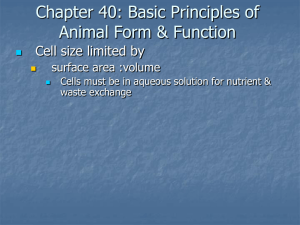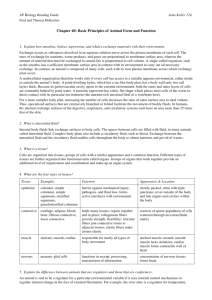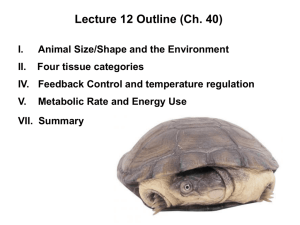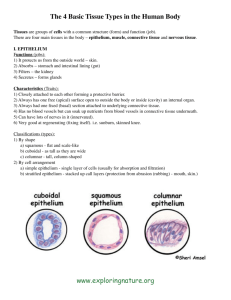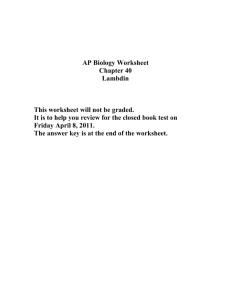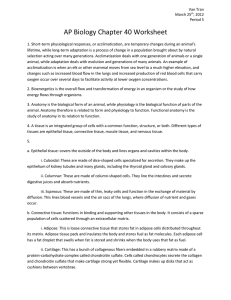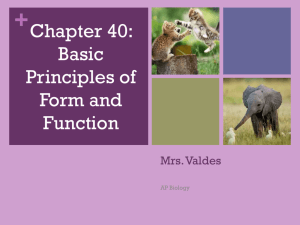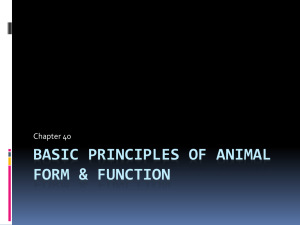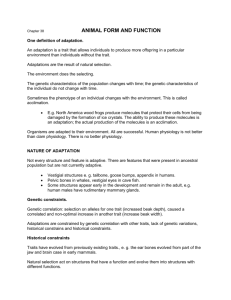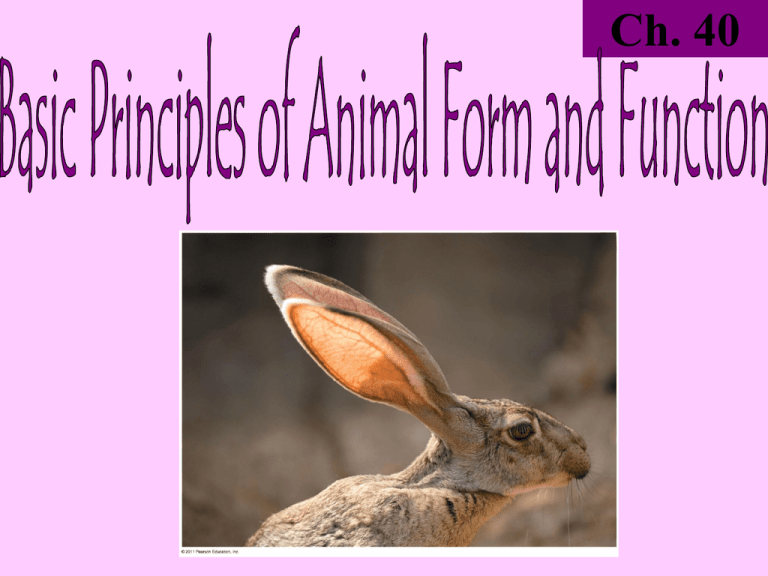
Ch. 40
Diverse Forms, Common Challenges
Correlation between form and function
• functions are properties that emerge from the
specific shape and order of body parts
Capacity to respond to stimuli
• long term – adaptation
• short term – physiological responses
Anatomy
• Biological form of an animal
Physiology
• Biological function
Evolution of Animal Size and Shape
Animals forms limited by…
• Strength
• Diffusion
• Movement
• Heat exchange
• Maximum size
Exchange with the Environment
Imposes limitations on body plans and number of
cells
Plasma membrane
• Rate of exchange for nutrients, wastes, and gases
are proportional to SA
Exchange with the Environment
Larger animals have
adaptations of their
exchange surface that
are extensively
branched or folded
Interstitial fluid
• Fills spaces between
cells
• Link exchange
surfaces to body cells
•
Hierarchical Organization of Body Plans
• Atoms molecules supramolecular
structures cell
• Cell tissues organs organ systems
Hierarchical Organization of Body Plans
• Function correlates with structure in tissues
• Tissue
– groups of cells with common structure and
function
• 4 Main Types…
– Epithelial Tissue
– Connective Tissue
– Nervous Tissue
– Muscle Tissue
Epithelial Tissue
• Sheets of tightly packed cells
– tight junctions
Functions
• barrier against mechanical injury, invading
microbes, and fluid loss
• free surface exposed to air or fluid
– Underneath bound to connective tissue by a
basement membrane
• may be specialized for absorption or
excretion
Types of Epithelial Tissue
•
•
•
•
•
•
•
•
Simple epithelium
Stratified epithelium
Pseudostratified
Columnar
Cuboidal
Squamous
Transitional
Glandular
Connective Tissue
• Sparse cell population scattered through an
extensive extracellular matrix
Consists of 3 types of fibers
• Collagenous (thick)
• Elastic (thin and flexible)
• Reticular
Connective Tissue
• Functions
– holds organs in place
– attaches epithelia to underlying tissues
• Cell types
– fibroblasts
– macrophages
Types of Connective Tissue
• Loose connective
• Adipose
– Fat
• Fibrous connective
– Tendons (muscle to bone)
– Ligaments (bone to bone)
• Cartilage
– chondrocytes
• Bone
– osteocytes
• Blood
– RBC, WBC, platelets
Nervous Tissue
• Senses stimuli and
transmits signals from
one part of the animal
to another
• Neuron
– nerve cell
specialized to
conduct an impulse
or biochemical
signal
Nervous Tissue – Neuron Structure
• Cell Body
• Dendrites
– extensions that
conduct impulses to
the cell body
• Axon
– extensions that
transmit impulses
away from the cell
body
Muscle Tissue
• Most abundant
type in animals
• Long, excitable
cells capable of
contraction
• Contain
contractile
microfilaments
– actin and
myosin
3 Types of Muscle
Tissue
Skeletal
• voluntary movements
• striated
Cardiac
• contractile wall of heart
• Light striations, intercalated disks
• involuntary
Smooth
• internal organs
• No striations
• involuntary
Organs
Systems are interdependent
• an organism is a living whole greater than the
sum of its parts
Organ systems
• several organs with separate functions that act in
a coordinated manner
Mesenteries
• sheets that suspend the organs
Hierarchical Organization of Body Plans
Hierarchical Organization of Body Plans
Coordination & Control
Coordination requires communication
between different body locations
Endocrine system
• Hormones from endocrine system
reach all locations via the blood
• Slow acting but effects are long
lasting
Nervous system
• Fast acting but only last a fraction of
a second
• Neurons transmit nerve impulses
between specific locations in the
body
– 4 types of cells can receive
impulses: other neurons, muscle,
endocrine, and exocrine cells
Regulating and Conforming
Regulator
• Uses internal mechanisms
to control internal change
in the face of external
fluctuation
Conformer
• Its internal condition
changes in accordance with
environmental variables
Can be both
Homeostasis
• “Steady state”
Mechanisms
• Set point
– Maintaining a set variable
• Stimulus
– Fluctuations in the variable
above or below the set point
• Sensor
– Receptor of fluctuation
• Response
– Physiological activity that helps
return the variable to the set
point
Feedback Control in Homeostasis
Negative Feedback
• Control that reduces the stimulus
Positive Feedback
• Amplifies the stimulus
Alterations
• Possible to change under certain
circumstances
• Circadian rhythm
Acclimitization
• Gradual process by which an
animal adjust to changes in its
external environment
Negative Feedback
Negative
Feedback –
Body
Temperature
Positive Feedback
Thermoregulation
Process by which animals
maintain an internal
temperature within a
tolerable range
Endothermic
• Warmed mostly by
metabolism
Ectothermic
• Gain most of their heat
from the environment
Poikilotherm vs.
Homeotherm
Balancing Heat Loss and Gain
Animal’s ability to control its
exchange of heat with the
environment
• Integumentary system
Four physical processes
• Radiation
• Evaporation
• Convection
• Conduction
Balancing Heat Loss and Gain
Insulation
• Reduces heat flow b/w animal
and environment
• Fluffing of feathers, line
fur/feathers with oil, fat,
goose bumps
Circulatory Adaptations
• Vasodilation and
vasoconstriction
• Countercurrent exchange
Balancing Heat Loss and Gain
Cooling by Evaporative Heat Loss
• Sweating, panting, bathing
Behavioral Responses
• Hibernation, migration, basking,
huddling
Adjust Metabolic Heat Production
• Thermogenesis (moving,
shivering)
• Nonshivering thermogenesis
• Brown fat
Acclimitization in Thermoregulation
Seasonal changes
Adjustments at cellular level
• Production of different enzymes
• Proportion of saturated and unsaturated lipids
• “Antifreeze” compounds in membranes
Physiological Thermostats and Fever
Hypothalamus
• Group of cells
function as a
thermostat
Negative
Feedback
Energy Requirements Related to Animal
Size, Activity, and Environment
Bioenergetics
• Overall flow and transformation of energy in an
animal
Age, sex, size
Body temp.
Environmental temp.
Food quality and quantity
Activity level
Amount of available O2
Hormonal balance
Time of day
Metabolic Rates
Amount of energy an animal uses ina unit of time
Metabolic rate is inversely proportional to body
size
• smaller animals
• consume more calories per gram
• higher breathing rates
• more blood volume
• higher heart rates
Metabolic Rates
Basal Metabolic Rate (BMR)
• Minimum metabolic rate of a nongrowing
endotherm that is at rest, has an empty stomach,
and is not experiencing stress
Standard Metabolic Rate
• Metabolic rate of a fasting, nonstressed
ectotherm at rest at a particular temperature
Energy Budgets
Torpor and Energy Conservation
Physiological state of decreased activity
and metabolism
• Animals can save energy while avoiding
dangerous/difficult situations
Daily torpor
Hibernation
Estivation

